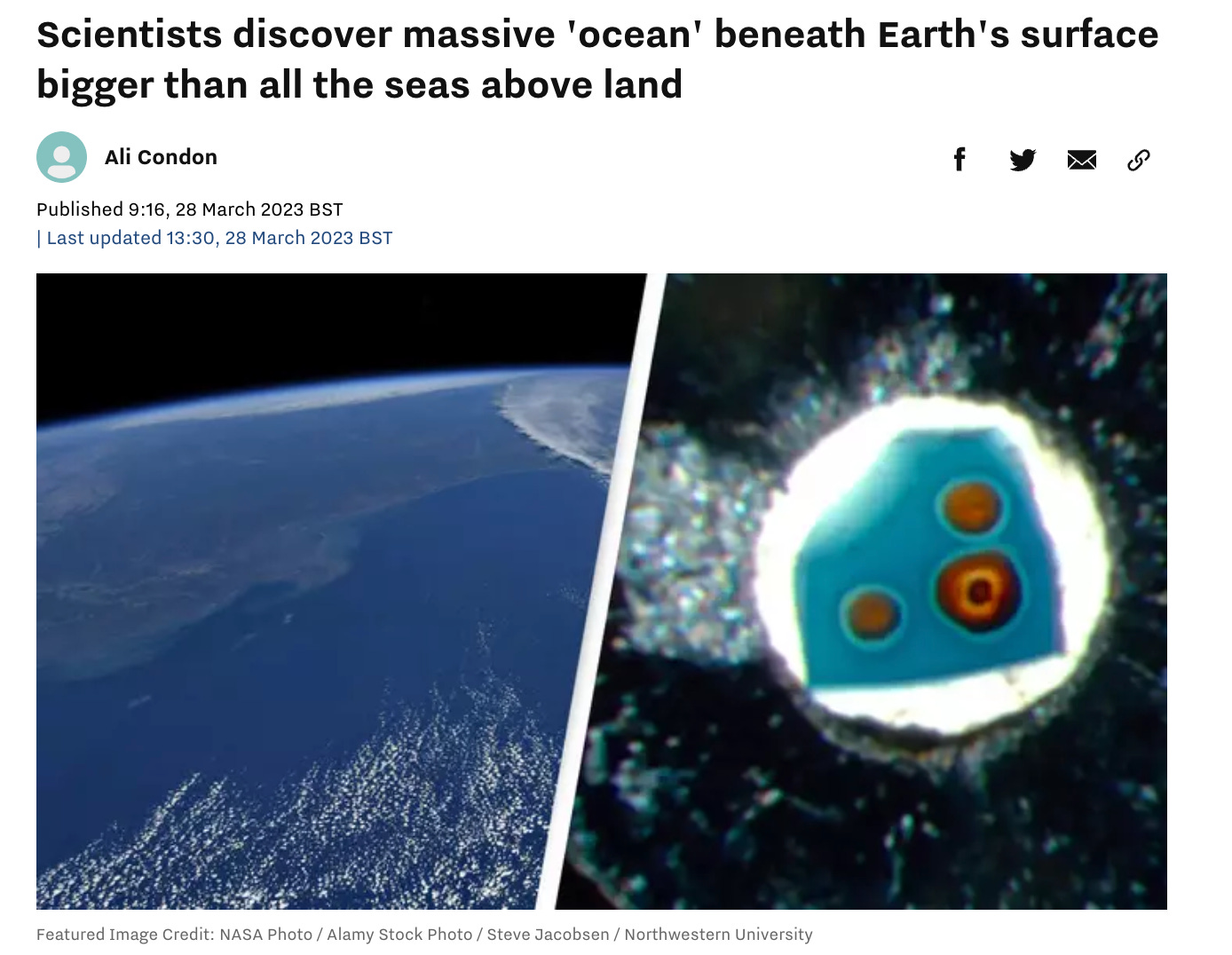Fact check: The Bible's fountains of the deep... exist.
Since the nineteenth century scientists said that the Great Flood could not have happened because the fountains of the great deep mentioned in Genesis do not exist. Well, it seems that they do...
In the six hundredth year of Noah’s life, on the seventeenth day of the second month, all the fountains of the great deep burst forth, and the floodgates of the heavens were opened. Genesis 7:11
One of the arguments against a global flood has always been that these ‘fountains of the great deep’ do not exist.
Well, it looks as though they do.
An article on the science site Unilad has gone viral about a massive ocean in the Earth’s mantle, more than 400-600 kilometres beneath the Earth’s surface, that may hold 3 times more water than the oceans on the surface.
This is old research – it was discovered in 2014 - but it has gone viral because Joe Rogan shared the article on instagram, saying:
“Me: man, it's after 2am, I should probably get some sleep. Article: "Did you know that there's an absolutely massive supply of water hidden underneath the Earth's crust that's three times bigger than the oceans that sit on the surface?" Me: No, I did not know that. And now that's all I'm interested in. F*** sleep, it's rabbit hole time.”
The article points out that scientists in 2014 discovered that there is a huge reservoir of water 400 miles underneath the earth’s surface, in the earth’s mantle, contained within a mineral called ringwoodite.
"The ringwoodite is like a sponge, soaking up water, there is something very special about the crystal structure of ringwoodite that allows it to attract hydrogen and trap water," said geophysicist Steve Jacobsen, who was part of the monumental discovery.
"This mineral can contain a lot of water under conditions of the deep mantle."
Scientists from Illinois University had been using seismometers to measure the waves generated by earthquakes across the US. They discovered that the waves travelled underground for hundreds of kilometres.
In their research, they found that the waves weren't limited to the Earth's surface, but moving throughout the planet's core.
By measuring the speed and depth of those waves, researchers were able to work out what sort of rocks the water was being contained in - landing on ringwoodite in the end.
Research has found that ringwoodite can contain up to 1.5 percent water.
If the ringwoodite under the surface has just 1 percent water in its molecular build-up, it would mean that it holds three times more water than all of the oceans on the Earth's surface.
It was this great article in NotTheBee that alerted me to this story:
The original article these stories are referring to was published in Science 2014:
Dehydration melting at the top of the lower mantle Brandon Schmandt and Steven D. Jacobsen and Thorsten W. Becker and Zhenxian Liu and Kenneth G. Dueker doi:10.1126/science.1253358, Science volume = 344 pages 1265-1268, 2014 https://www.science.org/doi/abs/10.1126/science.1253358
Cycling water through the transition zone
The water cycle involves more than just the water that circulates between the atmosphere, oceans, and surface waters. It extends deep into Earth's interior as the oceanic crust subducts, or slides, under adjoining plates of crust and sinks into the mantle, carrying water with it. Schmandt et al. combined seismological observations beneath North America with geodynamical modeling and high-pressure and -temperature melting experiments. They conclude that the mantle transition zone—410 to 660 km below Earth's surface—acts as a large reservoir of water.
Abstract
The high water storage capacity of minerals in Earth’s mantle transition zone (410- to 660-kilometer depth) implies the possibility of a deep H2O reservoir, which could cause dehydration melting of vertically flowing mantle. We examined the effects of downwelling from the transition zone into the lower mantle with high-pressure laboratory experiments, numerical modeling, and seismic P-to-S conversions recorded by a dense seismic array in North America. In experiments, the transition of hydrous ringwoodite to perovskite and (Mg,Fe)O produces intergranular melt. Detections of abrupt decreases in seismic velocity where downwelling mantle is inferred are consistent with partial melt below 660 kilometers. These results suggest hydration of a large region of the transition zone and that dehydration melting may act to trap H2O in the transition zone.




